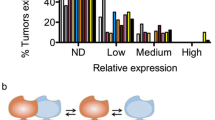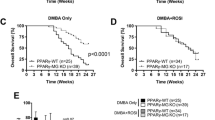Abstract
Introduction
Peroxisome proliferator-activated receptor gamma (PPAR-γ) and retinoic acid receptors (RAR/RXR) belong to the nuclear steroid receptor family. In vitro studies have suggested that PPAR-γ ligands are highly effective in preventing mammary tumours and these effects are enhanced by some retinoids. However, in vivo anti-initiator and anti-promoter efficacies of this combination are not clear.
Aim and methods
The present study aimed to investigate the chemopreventive efficacies of the PPAR-γ ligand rosiglitazone (200 μg/kg/day), synthetic retinoid fenretinide (0.3 mg/kg/day) and their combination on a DMBA-induced rat mammary carcinogenesis model.
Results
In the rosiglitazone group, no malignant tumour developed, apart from the lowest proliferative mammary lesions. In the fenretinide group, 30% developed a malignant tumour but there were no benign tumours. Cancer incidences were 61.5% and 10% in the control and combination groups respectively.
Conclusions
Our results showed that the PPAR-γ ligand rosiglitazone and synthetic retinoid fenretinide have potent chemopreventive properties against in vivo mammary carcinogenesis; however, the efficacies were not enhanced by their combination.
Similar content being viewed by others
References
Mangelsdorf DJ, Thummel C, Beato M et al (1995) The nuclear receptor superfamily: the second decade. Cell 83:835–839
Aranda A, Pascual A (2001) Nuclear hormone receptors and gene expression. Physiol Rev 81:1269–1304
Shen Q, Brown PH (2003) Novel agents for the prevention of breast cancer: targeting transcription factors and signal transduction pathways. J Mammary Gland Biol Neoplasia 8:45–73
Lotan R (1996) Retinoids in cancer chemoprevention. FASEB J 10:1031–1039
Hansen LA, Sigman CC, Andreola F et al (2000) Retinoids and chemoprevention and differentiation therapy. Carcinogenesis 21:1271–1279
DeLuca LM (1991) Retinoids and their receptors in differentiation, embryogenesis and neoplasia. FASEB J 5:2924–2933
Zusi FC, Lorenzi MV, Vivat-Hannah V (2002) Selective retinoids and rexinoids in cancer therapy and chemoprevention. Drug Discov Today 7:1165–1174
Altucci L, Gronemeyer H (2001) The promise of retinoids to fight against cancer. Nat Rev Cancer 1:181–193
Sabichi AL, Xu H, Fischer S et al (2003) Retinoid receptor-dependent and independent biological activities of novel fenretinide analogues and metabolites. Clin Cancer Res 9:4606–4613
Sun SY, Lotan R (2002) Retinoids and their receptors in cancer development and chemoprevention. Crit Rev Oncol Hematol 41:41–55
Simeone AM, Tari AM (2004) How retinoids regulate breast cancer cell proliferation and apoptosis. Cell Mol Life Sci 61:1475–1484
Lippman SM, Lotan R (2000) Advances in the development of retinoids as chemopreventive agents. J Nutr 130:479S–482S
Roberts-Thompson SJ (2000) Peroxisome proliferator-activated receptors in tumorigenesis: targets of tumour promotion and treatment. Immunol Cell Biol 78:436–441
Koeffner HP (2003) Peroxisome proliferator-activated receptor γ and cancers. Clin Cancer Res 9:1–9
Pighetti GM, Novosad W, Nicholson C et al (2001) Therapeutic treatment of DMBA-induced mammary tumors with PPAR ligands. Anticancer Res 21:825–829
Elstner E, Müller C, Koshizuka K et al (1998) Ligands for peroxisome proliferator-activated receptor γ and retinoic acid receptor inhibit growth and induce apoptosis of human breast cancer cells in vitro and in BNX mice. Proc Natl Acad Sci 95:8806–8811
Mehta RG, Williamson E, Patel MK, Koeffner HP (2000) A ligand of peroxisome proliferator-activated receptor-γ, retinoids, and prevention of preneoplastic mammary lesions. J Natl Cancer Inst 92:418–423
Szanto A, Nagy L (2005) Retinoids potentiate PPAR-γ action in differentiation, gene expression and lipid metabolic processes in developing myeloid cells. Mol Pharmacol 67:1935–1943
Elstner E, Williamson EA, Zang C et al (2002) Novel therapeutic approach: ligands for PPAR-gamma and retinoid receptors induce apoptosis in bcl-2-positive human breast cancer cells. Breast Cancer Res Treat 74:155–165
Serrano D, Perego E, Costa A, Decensi A (2004) Progress in chemoprevention of breast cancer. Crit Rev Oncol Hematol 49:109–117
Torrisi R, Decensi A, Formelli F et al (2001) Chemoprevention of breast cancer with fenretinide. Drugs 61:909–918
Wu JM, DiPietrantonio AM, Hsieh TC (2003) Mechanism of fenretinide (4-HPR)-induced cell death. Apoptosis 6:377–388
Dmitrovsky E (2004) Fenretinide activates a distinct apoptotic pathway. J Natl Cancer Inst 96:1264–1265
Renehan AG, Egger M, Minder C et al (2005) IGF-1, IGF binding protein-3 and breast cancer risk: comparison of 3 meta-analyses. Int J Cancer 115:1006–1007
Larsson O, Girnita A, Girnita L (2005) Role of insulin-like growth factor I receptor signalling in cancer. Br J Cancer 92:2097–2101
Pollak M (2000) Insulin-like growth factor physiology and cancer risk. Eur J Cancer 36:1224–1228
Mehta RG (2000) Experimental basis for the prevention of breast cancer. Eur J Cancer 36:1275–1282
Umrani DN, Banday AA, Hussain T, Lokhandwala MF (2002) Rosiglitazone treatment restores renal dopamine receptor function in obese Zucker rats. Hypertension 40:880–885
Cardiff RD, Anver MR, Gusterson BA et al (2000) The mammary pathology of genetically engineered mice: the consensus report and recommendations from Annapolis meeting. Oncogene 19:968–988
Prochazkova J, Kylarova D, Vranka P, Lichnosky V (2003) Comparative study of apoptosis-detecting techniques: TUNEL, apostain and lamin B. Biotechniques 35:528–534
Frankfurt OS, Robb JA, Sugarbaker EV, Villa L (2000) Monoclonal antibody to single-strand DNA is a specific and sensitive cellular marker of apoptosis. Exp Cell Res 226:387–397
McCormick DL, Burns FJ, Albert RE (1980) Inhibition of rat mammary carcinogenesis by short dietary exposure to retinyl acetate. Cancer Res 40:1140–1143
Harris G, Ghazallah RA, Nascene D et al (2005) PPAR activation and decreased proliferation in oral carcinoma cells with 4-HPR. Otolaryngol Head Neck Surg 133:695–701
Peng X, Wood S, Bratescu L et al (2005) Retinoids suppress premalignant MCF10AT but not malignant MCF10CA1a breast epithelial cells in vivo. Role of retinoic acid receptor β2 expression. Cancer Lett 222:153–163
Green A, Shilkaitis A, Christov K (1999) 4-(Hydroxyphenyl)retinamide selectively inhibits the development and progression of ductal hyperplastic lesions and carcinoma in situ in mammary gland. Carcinogenesis 20:1535–1540
Russo IH, Russo J (1998) Role of hormones in mammary cancer initiation and progression. J Mammary Gland Biol Neoplasia 3:49–61
Russo IH, Russo J (2007) Primary prevention of breast cancer by hormone-induced differentiation. Recent Results Cancer Res 174:111–130
Russo J, Russo IH (2004) Development of human breast. Maturitas 49:2–15
Russo J, Mailo D, Hu YF et al (2005) Breast differentiation and implication in cancer prevention. Clin Cancer Res 11:931s–936s
Thompson HJ, Singh M (2000) Rat models of premalignant breast disease. J Mammary Gland Biol Neoplasia 5:409–420
Heaney AP, Fernando M, Melmed S (2003) PPAR-γ receptor ligands: novel therapy for pituitary adenomas. J Clin Invest 111:1381–1388
Fürstenberger G, Senn HJ (2002) Insulin-like growth factors and cancer. Lancet Oncol 3:298–302
Renehan AG, Zwahlen M, Minder C et al (2004) Insulin-like growth factor (IGF)-I, IGF binding protein-3, and cancer risk: systematic review and meta-regression analysis. Lancet 9418:1346–1353
Torrisi R, Parodi S, Fontana V et al (1998) Effect of fenretinide on plasma IGF-1 and IGFBP-3 in early breast cancer patients. Int J Cancer 76:787–790
Author information
Authors and Affiliations
Corresponding author
Rights and permissions
About this article
Cite this article
Kocdor, H., Kocdor, M.A., Canda, T. et al. Chemopreventive efficacies of rosiglitazone, fenretinide and their combination against rat mammary carcinogenesis. Clin Transl Oncol 11, 243–249 (2009). https://doi.org/10.1007/s12094-009-0347-5
Received:
Accepted:
Published:
Issue Date:
DOI: https://doi.org/10.1007/s12094-009-0347-5




